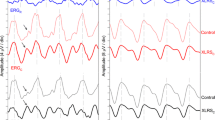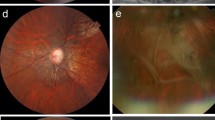Abstract
An unusual form of retinal degeneration is reported in 15-year-old girl and 11-year-old girl with different pedigrees, which resembles the cases reported by Gouras and associates (1983). The subjective symptoms in these patients included decreased visual acuity, photophobia, anomalous color vision and night blindness. Electroretinograms (ERGs) in these two patients were identical in substance and revealed drastic alterations in both photopic and scotopic functions. The stimulus versus intensity response curve in a single-flash ERG showed an unusual form. This peculiar supernormal response was elicited by bright stimuli although the stimulus threshold was extremely elevated.
Similar content being viewed by others
References
Abraham FA and Sandber MA (1977) An unusual type of juvenile foveal dystrophy: Electrophysiologic study. Doc Ophthalmol Proc Series 11:75–83
Alexander KR and Fishman GA (1984) Supernormal scotopic ERG in cone dystrophy. Brit J Ophthalmol 68:69–78
Alpern M, Falls HF and Lee GB (1960) The Enigma of typical total monochromacy. Am J Ophthalmol 50:996–1012
Alpern M (1974) Remarks on receipt of the Friedenwald Award. What is it that confines in a world without color? Invest Ophthalmol 13:647–674
Berson EL, Gouras P and Gunkel RD (1968a) Rod responses in retinitis pigmentosa, dominantly inherited. Arch Ophthalmol 80:58–67
Berson EL, Gouras P and Gunkel RD (1968b) Progressive cone-rod degeneration. Arch Ophthalmol 80:68–76
Berson, EL, Gouras P and Gunkel RD (1968c) Progressive cone degeneration, dominantly inherited. Arch Ophthalmol 80:77–82
Gouras P, Eggers HM and Mackay CJ (1983) Cone dystrophy, nyctalopia, and supernormal rod responses. A new retinal degeneration. Arch Ophthalmol 101:718–724
Krill AE (1968) The electroretinogram in congenital color vision defects. The clinical value of electroretinography. Retinal Degenerations, ERG, and Optic Pathways, ed. Nakajima A. Proceedings of 4th ISCERG symposium 1966 Basel and New York Karger, pp 205–214
Lipton SA, Rasmussen H and Dowling JE (1977) Electrical and adaptive properties of rod photoreceptors in Bufo marinus: II. Effects of cyclic nucleotides and prostaglandins. J Gen Physiol 70:771–791
Miyake Y, Yasuma T and Awaya S (1980) Familial, nonprogressive cone-rod dysfunction syndrome. Jpn J Clin Ophthalmol 34:377–385
Nicol GD and Miller WH (1978) Cyclic GMP injected into retinal rod outer segments increases latency and amplitude of response to illumination. Proc Natl Acad Sci USA 75:5217–5220
Yagasaki K and Miyake Y (1983) Clinical application of the response of blue cone system studied with electroretinogram (ERG): Analysis of recording conditions and responses in normal subjects. Acta Soc Ophthalmol Jpn 87:98–105
Author information
Authors and Affiliations
Rights and permissions
About this article
Cite this article
Yagasaki, K., Miyake, Y., Litao, R.E. et al. Two cases of retinal degeneration with an unusual form of electroretinogram. Doc Ophthalmol 63, 73–82 (1986). https://doi.org/10.1007/BF00153014
Issue Date:
DOI: https://doi.org/10.1007/BF00153014




